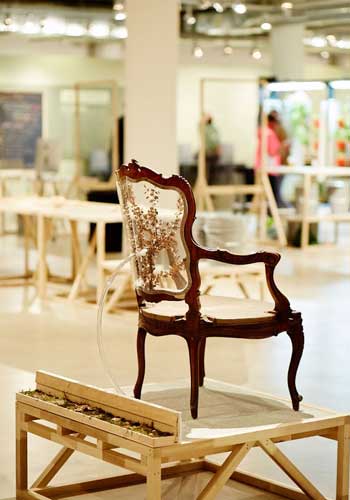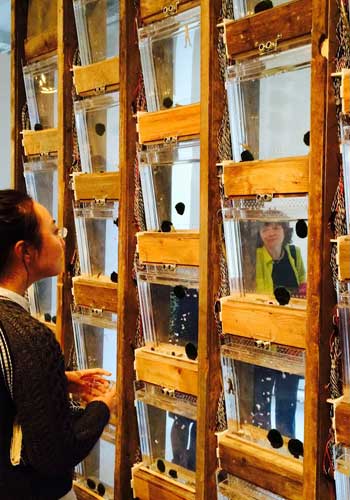HOW TO RE-WEIRD DESIGN
Can leaving the comfort zone push designers to re-imagine what is possible? Outside Design, an exhibition at the School of the Art Institute of Chicago (SAIC)’s Sullivan Gallery, shows that the answer to this question is yes. During a talk at the gallery, Jonathan Solomon, director of architecture, interior architecture, and designed objects at SAIC, called for leaving the usual behind and “re-weirding the discipline of design,” which can allow designers and artists to innovate and move beyond disciplinary boundaries. The exhibition is part of the Chicago Architecture Biennial and features the work of five firms of artists and designers: Analog Media Lab (Urbana-Champaign, Illinois), Ants of the Prairie (Buffalo, New York), The Living and the Ali Brivanlou Lab (New York City), Species of Space (Chicago), and Sweet Water Foundation (Chicago). Solomon curated the gallery as a “series of laboratories.”
To re-weird design, as Solomon explains, designers must design outside of their wheelhouse. They have to explore ideas and processes that push both the design and themselves, and go beyond clients’ comfort levels. It may also call for designers to look outside — literally. Designers should see the “complexity of nature and ecology” as an inspiration for design and art, as well as a potential means to create a more sustainable future.
David Hays of Analog Media Lab describes their work as “purposeful, pragmatic, and playful” yet grounded in experimentation. Their Rococo Chair riffs on the floral designs of Rococo-era upholstery fabrics, replacing them with actual flowers sandwiched between clear plastic (see image above). However, these flowers aren’t sealed up; they are allowed to decay. The flowers in the chair are dynamic, making the “rococo image real.”
Moving up to the scale of the building, both Ants of the Prairie and The Living propose re-wierding building façades, integrating them with the natural world.
Whether we like it or not, animals and bugs live with us in and around our homes. How do we reveal and enhance this relationship? Joyce Hwang of Ants of the Prairie created her installation, Habitat Wall, as an “inhabitable living membrane.” Built of different types of wood, including salvaged and reclaimed pieces, and composed of a series of modules, Habitat Wall is a beautiful physical object, but also functions as nesting houses and ledges for bats and birds, allowing both people and creatures to live together.
Designing at the intersection of biology and architecture, David Benjamin of The Living works with biologist Ali Brivanlou to co-create a façade with nature. They designed Amphibious Envelope, a façade wherein the traditional double-paned glass is replaced with tanks filled with water, moss, frogs, and snails. As the oxygen levels in the wall lower, the frogs rise to the top of the water, triggering sensors which release air bubbles, thus re-oxygenating both the water and the air around the wall. The installation is both a “functional façade” and an “open-ended experiment” that allows for a more fluid relationship between the inside and outside.
And the process of re-weirding design can be expanded yet again to the scale of the public realm.
Eric Elison of Species of Space plays with questions of language and people’s perception of public space. A book case built on an angle and a dream machine, a spinning strobe in a dark room that produces visual hallucinations, are a means to change our perception. Elison also is in the process of mapping poems of cities, to create a “physical manifestation of language and design.”
For Emmanual Pratt of Sweet Water Foundation (SWF), an ecosystem can be both a physical natural process and a network of people. SWF “transforms blight into life” through their internship model, which trains students in aquaponics and ultimately encourages them to create a “decentralized network of sharing.” The aquaponics ecosystem then becomes an ecosystem of community partners and users. Their installation, Aquapons, highlights the importance of a sustainable system.
Outside Design shows us how small changes in perception can yield interesting results. Designers owe it to themselves to look outside the usual design processes. Inspiration may come in the form of bats, frogs, or poetry. Everyone should be open to the opportunities “re-weirding” can provide.
A number of lectures exploring the ideas of Outside Design are scheduled through November. The exhibit runs through December 19.
This guest post is by Heidi Petersen, Associate ASLA.














Follow Us!